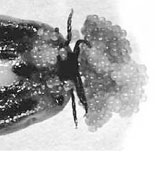 |
||||
Division of Bacteriology & Parasitology The most extensive divisional program is on Lyme disease, or Lyme borreliosis. An emerging infectious disease that affects people in North America, Europe, and Asia, Lyme borreliosis is caused by the spirochete Borrelia burgdorferi and is transmitted by ticks. The disease may manifest in numerous ways, e.g. as an inflammation of the skin (erythema migrans), as arthritis, and in the peripheral and central nervous systems as, for example, facial paralysis and through neurocognitive symptoms. Lyme disease that affects the nervous system is also called Lyme neuroborreliosis. After developing a nonhuman primate model of Lyme disease, divisional faculty are currently using this model to try to understand the pathogenesis of neuroborreliosis of the central nervous system. Improvement of methods for the serological diagnosis of Lyme disease is also of major interest to divisional faculty. The significance of this line of research stems from the fact that Lyme disease that is accurately diagnosed early in the course of infection is more efficaciously treated with antibiotics than when the disease remains undiagnosed for extended periods. The C6 test, an antibody detection assay that is more sensitive and specific than the tests available heretofore, was developed by investigators in the Division. An additional advantage is that the test does not yield false-positive results with serum specimens from humans or dogs that have received Lyme disease vaccination. The test was approved by the FDA and the USDA for human and animal use, respectively, and licensed by Tulane University to Immunetics, Inc., of Cambridge, MA, for human use, and to IDEXX Laboratories, Inc. of Westbrook, ME, for veterinary purposes. Currently research on diagnosis is focused on the C6 test as a predictor of Lyme disease therapy outcome, a possible new application of the test. The spirochete B. burgdorferi has evolved numerous mechanisms of adaptation to which it must resort in order to survive in different host organs, in environments as dissimilar as ticks and mice, and in the face of a swift and intense immune response. Divisional scientists are researching the mechanisms of gene regulation that underpin these survival stratagems. Important findings have been made in relation to spirochetal adaptation to different cell densities and to changes in environmental pH and temperature, as well as relating to the ability of this organism to circumvent the antibody response of the host.
|
|
©2013 Tulane University |
